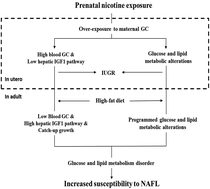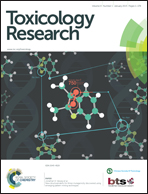Prenatal nicotine exposure-induced intrauterine programming alteration increases the susceptibility of high-fat diet-induced non-alcoholic simple fatty liver in female adult offspring rats†
Abstract
Previous studies have indicated that the intrauterine growth retardation (IUGR) fetus is faced with a high susceptibility to adult metabolic syndrome (MS). Non-alcoholic simple fatty liver (NAFL) is considered to be the hepatic manifestation of MS. In the present study, we evaluated the susceptibility of high-fat diet-induced NAFL in female adult IUGR offspring rats, induced by prenatal nicotine exposure, and we further explored the underlying intrauterine programming mechanism for this phenomenon. The IUGR rat model was established by prenatal exposure to nicotine (2 mg kg−1 d−1), the liver tissues from female fetuses and female adult offspring fed with normal or high-fat diets were collected. The female adult offspring in the nicotine-exposed group showed low birth weights and postnatal catch-up growth, as well as severe NAFL under high-fat diets. Moreover, increased gene expression involved in the hepatic insulin-like growth factor 1 (IGF1) pathway, gluconeogenesis and lipid synthesis, and decreased gene expression of lipid output accompanied with elevated serum triglyceride levels, was observed. The female fetuses in the nicotine-exposed group showed down-regulated hepatic IGF1 pathways, and also exhibited similar patterns of increased gluconeogenesis, lipid synthesis and decreased lipid output to those in the adults. The present study demonstrates the intrauterine origin of increased susceptibility to high-fat diet-induced NAFL in female offspring rats by prenatal nicotine exposure, which is most likely mediated by “two intrauterine programming”. That is, the first glucocorticoid-IGF1 axis programming induces postnatal catch-up growth, aggravates glucose and lipid metabolic disorders, and leads to an increased susceptibility to adult NAFL, while the second hepatic glucose and lipid metabolic programming enhances hepatic lipogenesis and reduces lipid oxidation and output, promoting NAFL.


 Please wait while we load your content...
Please wait while we load your content...